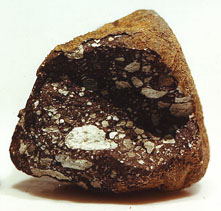Lunar meteorite
| Lunar meteorite (Lunaite) | |
|---|---|
| — Clan — | |

Lunar meteorite Allan Hills 81005
|
|
| Type | Achondrite |
| Subgroups |
|
| Parent body | Moon |
| Total known specimens | 164 |
| Alternative names | Lunaite |
A lunar meteorite is a meteorite that is known to have originated on the Moon. A meteorite hitting the Moon is normally classified as a transient lunar phenomenon.
In January 1982, John Schutt, leading an expedition in Antarctica for the ANSMET program, found a meteorite that he recognized to be unusual. Shortly thereafter, the meteorite now called Allan Hills 81005 was sent to Washington, DC, where Smithsonian Institution geochemist Brian Mason recognized that the sample was unlike any other known meteorite and resembled some rocks brought back from the Moon by the Apollo program. Several years later, Japanese scientists recognized that they had also collected a lunar meteorite, Yamato 791197, during the 1979 field season in Antarctica. About 134 lunar meteorites have been discovered so far (as of October, 2010), perhaps representing more than 50 separate meteorite falls (i.e., many of the stones are "paired" fragments of the same meteoroid). The total mass is more than 46 kilograms (101 lb). All lunar meteorites have been found in deserts; most have been found in Antarctica, northern Africa, and the Sultanate of Oman. None have yet been found in North America, South America, or Europe.
Lunar origin is established by comparing the mineralogy, the chemical composition, and the isotopic composition between meteorites and samples from the Moon collected by Apollo missions.
Most lunar meteorites are launched from the Moon by impacts making lunar craters of a few kilometers in diameter or less. No source crater of lunar meteorites has been positively identified, although there is speculation that the highly anomalous lunar meteorite Sayh al Uhaymir 169 derives from the Lalande impact crater on the lunar nearside.
...
Wikipedia
